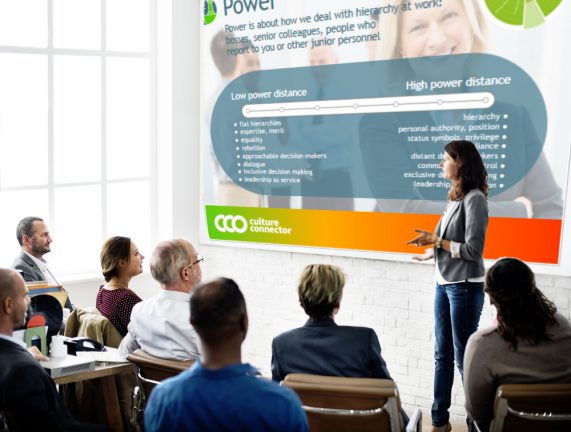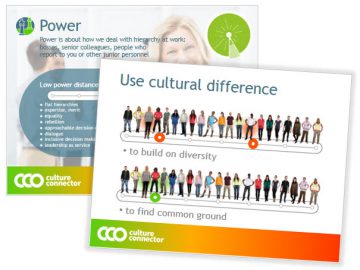Twelve ways to make sense of cultural differences when training teams, leaders and expatriates
Nov 10, 2016 · by Richard Farkas

Before the first coffee break in an intercultural training session, you may have already covered the main introductory and culture-general ideas, such as stereotypes, culture shock and the iceberg.
Popular culture-general topics for intercultural training
- what is culture?
- the iceberg
- the onion
- stages of culture shock
- stages of cultural sensitization
- myths, stereotypes and realities
Assuming there’s a culture-specific part to the programme, you’ll need to tackle the key differences which make the culture unique, but still understandable from an outside perspective.
Good ways to introduce a specific culture to training participants include some history, some personal stories and some visual, taste or simulated experience. And then how can we take training participants’ instinctive reaction and curiosity and bring transferable understanding?
Twelve cultural differences for intercultural trainers
Here are the 12 differences we use to introduce cultural diversity, in a comparative way.
 Space, or personal openness. From a trainer’s point of view, this raises great discussion points about practical issues, such as the impact of social media at work, social situations, partnering and building trust. This touches on deeply-held beliefs about family, personal v private life and what’s relevant in a work situation.
Space, or personal openness. From a trainer’s point of view, this raises great discussion points about practical issues, such as the impact of social media at work, social situations, partnering and building trust. This touches on deeply-held beliefs about family, personal v private life and what’s relevant in a work situation.
 Use of time, or following agendas and schedules. Training participants get this cultural difference quickly too. Everyone has a story to share, possibly fresh from the very day of the training. How many minutes pass before someone is late? What’s the right way to follow an agenda or to view a project plan?
Use of time, or following agendas and schedules. Training participants get this cultural difference quickly too. Everyone has a story to share, possibly fresh from the very day of the training. How many minutes pass before someone is late? What’s the right way to follow an agenda or to view a project plan?
 Time spans, or attitudes to tradition and future visions. In most organisations there is a change process happening, and it might even be the reason for the training. Depending on the kind of change, some will want to follow the vision while others might prefer to hold on to traditions, or look to the past for inspiration. This can be a sensitive but rich topic in training situations.
Time spans, or attitudes to tradition and future visions. In most organisations there is a change process happening, and it might even be the reason for the training. Depending on the kind of change, some will want to follow the vision while others might prefer to hold on to traditions, or look to the past for inspiration. This can be a sensitive but rich topic in training situations.
 Fate, or responses to challenging circumstances. Most teams and individuals will have experience of dealing with negative events. They could be global and economic, business restructuring, crisis or more local, for example uncertainty after the loss of a key person. The responses differ, and belief in our ability to influence events is an important factor here. Trainers have a great opportunity to explore the sources of motivation for training participants when the going gets tough and the commonly accepted responses in different cultures.
Fate, or responses to challenging circumstances. Most teams and individuals will have experience of dealing with negative events. They could be global and economic, business restructuring, crisis or more local, for example uncertainty after the loss of a key person. The responses differ, and belief in our ability to influence events is an important factor here. Trainers have a great opportunity to explore the sources of motivation for training participants when the going gets tough and the commonly accepted responses in different cultures.
 Rules, or interpreting laws and regulations according to the situation. Following the rules and not following the rules can become a source of great frustration in everyday cross-cultural life. Understanding of this cultural difference is especially relevant in working life in contract negotiations and implementing agreements. Many training participants have already identified this as a problem in their work and practical examples are quick to emerge in discussions during training.
Rules, or interpreting laws and regulations according to the situation. Following the rules and not following the rules can become a source of great frustration in everyday cross-cultural life. Understanding of this cultural difference is especially relevant in working life in contract negotiations and implementing agreements. Many training participants have already identified this as a problem in their work and practical examples are quick to emerge in discussions during training.
 Power, or dealing with bosses and junior people. Almost every training participant is rightly concerned to have a successful relationship with their boss, or the team that works for them. Participants with some experience are often willing to share opinions on what works and doesn’t work. Training participants are typically also motivated to understand better how hierarchies work across their whole organisation, the supply chain, public authorities and customer organisations. Skill at dealing with senior people from other cultures and showing leadership across cultures are often part of the business reasons for running intercultural training.
Power, or dealing with bosses and junior people. Almost every training participant is rightly concerned to have a successful relationship with their boss, or the team that works for them. Participants with some experience are often willing to share opinions on what works and doesn’t work. Training participants are typically also motivated to understand better how hierarchies work across their whole organisation, the supply chain, public authorities and customer organisations. Skill at dealing with senior people from other cultures and showing leadership across cultures are often part of the business reasons for running intercultural training.
 Responsibility, or taking the initiative. This key difference relates to very practical matters: what gets done and who decides on a day-to-day business. Getting the right amount of authority to decide your own work is sensitive and a key part of motivation. Cultural expectations differ. For trainers willing to tackle sensitive topics and achieve change, the result can be a breakthrough in understanding, collaboration and performance in multicultural teams and relationships with managers.
Responsibility, or taking the initiative. This key difference relates to very practical matters: what gets done and who decides on a day-to-day business. Getting the right amount of authority to decide your own work is sensitive and a key part of motivation. Cultural expectations differ. For trainers willing to tackle sensitive topics and achieve change, the result can be a breakthrough in understanding, collaboration and performance in multicultural teams and relationships with managers.
 Group membership, or team roles, networks and long-term obligations. How much should team members be expected to put the team’s interests before their own? And what are the many loyalties inside and outside of work which affect decisions at work? Answers to these questions vary across training groups, especially groups of mixed cultural background. For trainers there is an opportunity to set up group exercises and pose dilemmas which highlight the different approaches to group membership.
Group membership, or team roles, networks and long-term obligations. How much should team members be expected to put the team’s interests before their own? And what are the many loyalties inside and outside of work which affect decisions at work? Answers to these questions vary across training groups, especially groups of mixed cultural background. For trainers there is an opportunity to set up group exercises and pose dilemmas which highlight the different approaches to group membership.
 Tasks, or nature and role of personal relationships at work. Some people focus on tasks from the very beginning, while others need to form a relationship before giving full effort. By looking at this key difference, a trainers can help people with project roles get their projects moving faster, and can show people in joint ventures and new partnerships the way to build trust and get things done. The topic is a fundamental one: why do we come to work and how do we judge success? It is also practical one about how to run meetings, schedule work and so on. This is a real cultural difference that can also affect the dynamic of your own training delivery.
Tasks, or nature and role of personal relationships at work. Some people focus on tasks from the very beginning, while others need to form a relationship before giving full effort. By looking at this key difference, a trainers can help people with project roles get their projects moving faster, and can show people in joint ventures and new partnerships the way to build trust and get things done. The topic is a fundamental one: why do we come to work and how do we judge success? It is also practical one about how to run meetings, schedule work and so on. This is a real cultural difference that can also affect the dynamic of your own training delivery.
 Directness, or communication style. Even when business fundamentals are solid and operations are culturally-adapted and sensitively managed, communication style can still divide and shock. Feelings about the wrong amount of respect, politeness and truth can be very powerful, influencing the tone of overall cooperation. For trainers, this is a relatively easy difference to simulate quickly in a training situation. But it is not just about the words people choose to use. It is also about how much communication is hidden below the surface, or mediated through third-parties and unofficial channels, so there are practical implications for training participants too.
Directness, or communication style. Even when business fundamentals are solid and operations are culturally-adapted and sensitively managed, communication style can still divide and shock. Feelings about the wrong amount of respect, politeness and truth can be very powerful, influencing the tone of overall cooperation. For trainers, this is a relatively easy difference to simulate quickly in a training situation. But it is not just about the words people choose to use. It is also about how much communication is hidden below the surface, or mediated through third-parties and unofficial channels, so there are practical implications for training participants too.
 Conflict, or how to move from different interests via disagreement to agreement and harmony. Whether it is named as a “conflict”, “disagreement”, or something more subtle, this key difference occurs in the real world and it may be a conflict of some kind that inspired your intercultural training. Some of your training participants may be professional negotiators with general skills for negotiation and conflict resolution. But there very different expectations and practices between cultures. This is a fertile topic for simulations and case studies in training.
Conflict, or how to move from different interests via disagreement to agreement and harmony. Whether it is named as a “conflict”, “disagreement”, or something more subtle, this key difference occurs in the real world and it may be a conflict of some kind that inspired your intercultural training. Some of your training participants may be professional negotiators with general skills for negotiation and conflict resolution. But there very different expectations and practices between cultures. This is a fertile topic for simulations and case studies in training.
 Problem solving, or the role of data v opinion and logic v instinct in arriving at decisions and solutions. Since many great solutions are built on a combination of inspiration and research, trainers case use this key difference to demonstrate how diverse teams can outperform monocultural ones.
Problem solving, or the role of data v opinion and logic v instinct in arriving at decisions and solutions. Since many great solutions are built on a combination of inspiration and research, trainers case use this key difference to demonstrate how diverse teams can outperform monocultural ones.
The 12 key differences represent very practical ways in which a person can improve their confidence, performance and satisfaction working across cultures. For trainers using CultureConnector, there are rich opportunities for giving training participants practical tools for navigating the differences in specific cultural situations yet to be encountered after the training.
Key differences
Nov 6, 2016 · by Richard Farkas
Everyone who uses CultureConnector gets a cultural profile based on 12 key areas where differences and common ground can mean success or failure in cross-cultural work. Here’s a brief look at the profile you’ll get from CultureConnector.
Resources for trainers
Requiring licence
- Trainer Help – free access to practical information and guides if you have a current Trainer Dashboard licence
- Accredited trainer resources – deeper dive and practical training exercises, with material, based on the 12 key differences. Requires current accredited trainer status.
Free
- More about training with CultureConnector
- How to integrate e-learning into your training
- Training material introducing the 12 key differences in PDF and PPTX format. Use it freely in your coaching and training.


